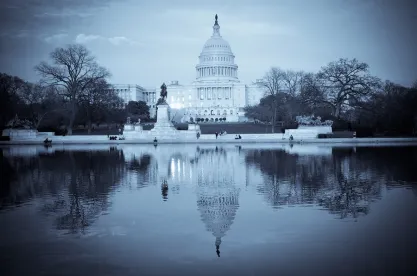The House and Senate will not return to Washington until July 20, but discussions among the “four corners” in the US Congress are underway with the intent of crafting a bipartisan COVID-19 relief measure that can be signed into law by President Donald Trump by the end of July.
House Speaker Nancy Pelosi (D-CA) and Senate Majority Leader Mitch McConnell (R-KY) are said to have met recently to begin laying the groundwork for formal negotiations that will determine the size and scope of the forthcoming bill. The White House in recent days has fallen in line with McConnell’s negotiating position, which calls for a measure in the US$1 trillion range. Democrats will begin talks having pushed more than US$5 trillion in new spending through the House.
Topics covered today include: appropriations, tax and economic development, health, trade, government oversight and investigations, US states developments.
With the US Congress not returning to session until the week of July 20, our briefing will continue on a modified publication schedule next week. The next briefing will be published on July 16.
POLITICO on Monday indicated that Mark Meadows, the North Carolina congressman-turned-White House chief of staff, would be the lead negotiator for the Trump Administration during the upcoming discussions over the next coronavirus response package. However, in remarks to reporters outside the White House later that day, Meadows said Treasury Secretary Steven Mnuchin would again assume that role.
Among the many key issues to be decided by negotiators: how to deal with the looming expiration of the enhanced unemployment benefits established by the bipartisan CARES Act this spring; how much, if any, federal aid will be provided to states, territories, cities and counties, and how such entities will be allowed to use it; whether to provide another round of direct “stimulus” payments to American consumers; and whether the bipartisan measure will include some type of liability shield that protects businesses and other entities from a flurry of COVID-19-related lawsuits as the economy reopens. Countless stakeholder organizations are lobbying Congress to have their priorities included as well – a scramble that has taken on particular urgency as it becomes increasingly likely that the next package will be the last one signed into law before the November election.
Legislative action on the anticipated COVID-19 bill is likely to begin in the Senate, which has yet to respond to House passage of the sprawling HEROES Act last May, as well as a massive national infrastructure bill approved by the House more recently. A veteran Republican Member of Congress predicts the bill will be a limited package that includes liability shield language as well as aid for states and communities patterned on the bipartisan SMART Act introduced months ago by Senators Bill Cassidy (R-LA) and Bob Menendez (D-NJ). The SMART legislation would provide approximately US$500 billion in new money for state and local governments – a significant new infusion of aid, but less than the amount approved in May by the House as part of the HEROES bill.
The national jobs report released last week by the US Bureau of Labor Statistics showed the unemployment rate in America continued to decline last month. A resurgence of coronavirus cases in parts of the country, however, coupled with fears that the pandemic may have inflicted lasting damage upon the US economy, will keep the pressure on the White House and Congress to reach a deal in the weeks ahead.
Appropriations Updates
The US federal government’s budget process, which commenced in February with the release of President Trump’s budget proposal for fiscal year 2021, came to an abrupt halt in mid-March as the COVID-19 pandemic took hold within the US, quickly overtaking the federal legislative process. The consideration of 12 annual spending bills to fund the entire US government took a back seat as attention in Congress focused on a series of economic stimulus and COVID-19 response bills, resulting in more than US$3 trillion in emergency spending.
The appropriations process resumed in the House of Representatives this week, and is scheduled to proceed expeditiously through the month of July. While both the House and Senate remain in recess until July 20, the House Appropriations Committee is diligently preparing funding measures for House floor consideration later this month. Over a three-day period this week, each of the 12 spending bills were approved by their respective subcommittees. Beginning today, and concluding next week, these measures will be debated and amended by the 53-member full Appropriations Committee. In a departure from tradition, all Committee markups this year are closed to the public but remain accessible to the public via Committee webcast.
The ceiling for annual discretionary funding in fiscal year 2021 is set in statute at US$1.375 trillion, a modest US$5 billion increase over last year’s spending levels. Under the funding measures released this week, however, House Democrats have proposed an additional US$247 billion in emergency spending. This reflects a nearly 18 percent increase over the spending levels established for fiscal year 2021 through the Bipartisan Budget Act of 2019 (Public Law 116-37). Most of these funding increases, developed without input from the House Republican minority, are directed toward addressing COVID-19 pandemic related priorities. The majority of this additional emergency funding will be strongly opposed by the Republican-controlled Senate.
Fiscal year 2021 funding measures also include a number of notable policy provisions that reflect the public discourse occurring in the US regarding race and the nation’s history. The Military Construction funding bill contains a provision prohibiting the use of funds for projects on military installations named after Confederate officers unless the base intends to rename the facility. Also, the Interior & Environment bill bars the use of federal funding to display the Confederate flag on National Park Service grounds, and orders the removal of Confederate statues and memorials from national parks. Further, the Legislative Branch bill orders that all statues or busts of historical figures with ties to the Confederacy be removed from the US Capitol. And, lastly, the Commerce-Justice-Science bill includes policing reforms and racial justice provisions requiring that state and local governments, as a precondition for receiving specific US federal grant funding, must comply with conditions established to improve policing practices. These include the elimination of racial profiling, excessive force and chokeholds, and “no-knock” warrants in drug cases, among other reforms.
Following approval by the full Appropriations Committee (in a largely partisan exercise), each of the spending bills will be packaged into so-called appropriations “mini-buses” to expedite final passage in the House during the last two weeks of July. Individual amendments will be combined into en bloc packages to encourage timely consideration of bills and to limit the total number of House floor votes under recently imposed, strict health and safety protocols. Most of the funding bills are expected to pass the House, primarily with support from the Democratic majority. The likely exception is the Homeland Security funding bill which, for the second consecutive year, will be ensnared by funding disputes over the US-Mexico border wall, as well as immigration and border provisions, in the bill.
The path forward in the Senate remains far more unsettled, as plans to begin marking up bills in June were sidelined by partisan disputes over additional funding for COVID-19 priorities, social justice funding, and other policy provisions. Much of the Senate’s time and attention in July will be focused on negotiating the next legislative response to the COVID-19 pandemic before the August congressional recess.
A great deal of progress will be made on spending bills in July, particularly in the House. However, with only 25 legislative days remaining between now and the November elections in the United States, Congress will likely forego final spending decisions until the end of the calendar year. A Continuing Resolution (CR) in September to prevent a government shutdown is a virtual guarantee before the new fiscal year begins on October 1.
Tax and Economic Development Updates
Last week, the Congressional Budget Office (CBO) released an updated reportwhich provides the baseline economic forecast as the basis for updating its budget projections for 2020 to 2030. While the CBO currently plans to release those budget projections later this summer, the data included in this report suggests that “the unemployment rate [will remain] above its prepandemic level through the end of the projection period.” Despite this projection, Secretary of Labor Eugene Scalia this past weekend suggested that the addition of nearly 5 million jobs during the month of June may serve as evidence that extending the expanded US$600 per week unemployment benefits provided under the CARES Act may not be necessary. Moreover, White House economic adviser Larry Kudlow is also beginning to message that additional direct payments to individuals should be “more targeted” than the US$1,200 direct payments provided by the CARES Act and additional direct payments proposed in the House Democrats’ HEROES Act. These positions, however, run counter to the policies that most Democrats are pursuing as part of the next COVID-19 relief package and are likely to be just some of the key areas that lawmakers will need to resolve in the weeks ahead.
Yesterday, the Small Business Administration (SBA), in consultation with the Treasury Department, released detailed loan-level data about the nearly 5 million loans approved through the Paycheck Protection Program (PPP). Specifically, SBA released a report providing business names, addresses, North American Industry Classification System codes, zip codes, business type, demographic data, non-profit information, name of lender, jobs supported, and loan amount ranges, along with overall statistics regarding dollars lent per state, loan amounts, top lenders and distribution by industry. As Politico notes, “[t]he release of data for loans larger than $150,000 divulges just a minority of the program’s total borrowers — more than 80 percent of the transactions were below that threshold — but it marked a significant step forward in transparency after the administration for months resisted requests by lawmakers and news organizations to share the recipients of the funds. The disclosure has huge consequences for lawmakers as negotiations begin on the next economic relief package, including additional support for businesses. Lawmakers say they want to target aid at hard-hit employers, but they’ve had little visibility into where the first wave of money went, until now.”
With the Federal Reserve now having made public the comments it received regarding the implementation of the Main Street Lending Program, Secretary Mnuchin is confirming there has been a “significant improvement in liquidity since the program was first announced.” The Treasury Secretary also recently indicated that he is “pleased that many banks, recognizing the challenges that this shock has posed for otherwise healthy businesses, have already been lending.” He also “encourage[d] all eligible lenders to participate and to begin submitting qualifying loans.” At the same time, Mr. Daleep Singh, Vice President of the Federal Reserve Bank of New York – which is overseeing the administration of the Secondary Market Corporate Credit Facility (SMCCF) – recently suggested that the “strategy from the start has been to diversify [the program’s] vendor and counterparty base in the post-launch phase.” According to Mr. Singh: “All of the contracts the New York Fed has signed are short term; each has a provision to cancel with 30 days’ notice. Given this flexibility, we are evaluating all contracts after 90 days, with priority on re-bidding those that were not competitively bid.” Additionally, though Mr. Singh acknowledged that the Federal Reserve Bank of New York is “actively exploring opportunities to diversify the range of potential vendors and counterparties [they] work with across facility activities,” he also made clear: “Since the SMCCF’s launch, as market functioning has improved, we have slowed the pace of purchases, from about $300 million per day to a bit under $200 million a day. If market conditions continue to improve, Fed purchases could slow further, potentially reaching very low levels or stopping entirely. This would not be a signal that the SMCCF’s doors were closed, but rather that markets are functioning well. Should conditions deteriorate, purchases would increase.”
Another recent CBO report reviewing trends in Internal Revenue Service (IRS) funding and enforcement efforts suggests that increasing the IRS’s funding for examinations and collections by US$20 billion over 10 years would increase revenues by US$61 billion, while increasing such funding by US$40 billion over 10 years would increase revenues by US$103 billion. The report comes amidst the fiscal year 2021 appropriations push, with the House having this week approved legislation that would provide a 5% increase in IRS funding.
Separately, according to Politico’s Bernie Becker:
Ways and Means Republicans are about to offer measures that would supply new tax breaks for drug development companies, including those that have yet to record revenues. The measures weren’t prompted by the coronavirus pandemic, but their supporters believe that lessons learned over the past few months make them more relevant than ever. Two bills from Rep. Devin Nunes (R-Calif.) would benefit businesses working on infectious diseases, providing research and development incentives to commercial-stage companies before they start bringing in revenue. Another bill, which would let passive investors in pre-revenue infectious disease companies use losses to offset income from other sources, comes from Rep. Mike Kelly (R-Pa.), who himself contracted Covid-19. A fourth bill, from Rep. Vern Buchanan (R-Fla.), would free up start-up businesses from net operating loss and general business tax credit limits after an ownership change. Nunes and Kelly could drop their bills as soon as today, while Buchanan’s will likely lag by a few days.”
Finally, the “Unity” Task Force created by former Vice President Joe Biden and Senator Bernie Sanders’ (D-VT) campaigns yesterday released a more than 100-page policy document, which includes a number of recommendations for “building a stronger economy.” Examples of these proposals include:
-
Creating a “Public Credit Reporting Agency” for consumers within the Consumer Financial Protection Bureau (CFPB), which would be used by all federal lending programs and require that private credit reporting companies provide their data to the agency.
-
Increasing funding “to provide more affordable housing, reduce prices, create jobs using clear labor standards for all federal housing spending, and decarbonize housing.”
-
Creating a national standard for housing appraisals.
-
Amending the Federal Reserve Act to require the Chairman of the Federal Reserve to report on the extent of racial employment and wage gaps and what the central bank is doing to reduce them.
-
Establishing bank accounts housed at the Federal Reserve, a Federal Reserve real-time payments system and US Postal Service banking services.
-
Maintaining and expanding the separation of retail banking from investment banking.
-
Pursuing legislative options to limit “predatory” interest rates on non-residential consumer lending.
With regard to the last point, note that the CFPB this week issued a final rule amending its 2017 regulations on payday, vehicle title and some high-cost installment loans. Specifically, the final rule rescinds the mandatory underwriting provisions of the 2017 rule after “reevaluating the legal and evidentiary bases for these provisions and finding them to be insufficient.” The final rule does not rescind or amend the payments provisions of the 2017 rule. According to the CFPB, “[c]onsumers utilizing small dollar loans continue to have robust consumer protections in place under the prohibition on unfair, deceptive, and abusive acts or practices in the Dodd-Frank Act, the payments provisions of the 2017 rule, and other provisions of federal and state law. Consumers also have increasingly innovative choices among competing small dollar products in the marketplace. Rescinding the mandatory underwriting provisions of the 2017 rule ensures that consumers have access to credit and competition in states that have decided to allow their residents to use such products, subject to state-law limitations.”
Health Updates
As students in some states are slated to begin school in one month, questions remain about policies surrounding their reopening. On Wednesday, President Trump threatened in a series of tweets to cut off federal funding for schools if they do not open this fall and said he disagreed with the “very tough & expensive guidelines” issued by the Center for Disease Control and Prevention (CDC). On the same day, Vice President Pence announced in a press briefing that there would be further forthcoming guidance from the CDC. Pence defended the president’s tweets, saying, “we don’t want the guidance from CDC to be a reason why schools don’t open. We want to partner with states, with local education officials, with governors, with local health officials, to find a way to meet their needs to open up. I think the president’s statement this morning was simply reflective of that desire.” Previous CDC guidance recommended schools implement policies requiring face coverings and social distancing, frequent cleaning and sanitation, and the restriction of the sharing of objects and supplies. Many teachers unions have slammed the push to reopen, but the administration is backing up their decision by pointing to recent guidance from the American Academy of Pediatrics that states, “all policy considerations for the coming school year should start with a goal of having students physically present in school.”
On Wednesday, the National Institutes of Health revealed the formation of a national clinical trial network to test COVID-19 vaccine candidates and other prevention tools. The COVID-19 Prevention Trials Network was established by merging four existing National Institute for Allergy and Infectious Disease (NIAID)-funded clinical trials networks in the cities of Durham, NC; Atlanta, GA; Los Angeles, CA; and Seattle, Washington. According to a statement from Health and Human Services (HHS) Secretary Alex Azar, “starting this summer, this new network will leverage existing infrastructure and engage communities to secure the thousands of volunteers needed for late-stage clinical trials of promising vaccines.”
On Monday, the Food and Drug Administration issued an Emergency Use Authorization (EUA) for a second antigen diagnostic test, known as the BD (Becton Dickinson) Veritor System for Rapid Detection of SARS-CoV-2. The EUA permits “point-of-care” tests, which allows patients to receive the assessment at their providers’ office. On Tuesday, the drug manufacturer Regeneron announced the initiation of Stage 3 clinical trials evaluating REGN-COV2, the company’s investigational double antibody cocktail for the treatment and prevention of COVID-19. The trials are being conducted jointly with the NIAID at approximately 100 sites and are expected to enroll 2,000 patients in the US.
Trade Updates
Later today, former Vice President Joe Biden, the presumptive Democratic presidential nominee, will deliver a speech in Pennsylvania where he will begin to lay out his four-pillared “Build Back Better” economic plan. As reported by POLITICO’s Megan Cassella, today’s remarks will focus on the trade and manufacturing pillar, which will emphasize “Buy American” provisions, tightening restrictions on what goods qualify as being made in the US, investing US$400 billion in government procurement, “cracking down on outsourcing, investing billions in research and development and creating at least 5 million jobs in manufacturing and innovation.” The remaining three pillars of this plan focus on clean energy, the caregiving workforce and racial equity.
On Wednesday, HHS Secretary Azar stated that President Trump may use his executive authorities to require pharmaceutical companies to make drugs domestically. White House trade advisor Peter Navarro reportedly penned a draft executive order early in the pandemic aimed at returning certain pharmaceutical and medical product supply chains back to the US. However, the document has reportedly faced objections from other officials in the administration concerned that any “Buy America” requirements on these goods could hamstring US response to the ongoing pandemic.
While the US-Mexico-Canada Agreement is now in force, Canadian Prime Minister Justin Trudeau remains concerned that the US is considering reimposing tariffs on aluminum and possibly steel. As reported by CBC, ongoing talks seek to address whether imports from Canada have surged since May 2019, when those tariffs were put on hold and if so by how much. The American Primary Aluminum Association, which represents two US producers, sent a letter to President Trump earlier this week urging action on Canadian imports, which they argue threaten US jobs. The Aluminum Association, a separate group, opposes any action to reimpose tariffs, arguing that imports have not changed substantially since 2017.
Oversight Updates
Following the SBA’s release of data on PPP loans Monday, numerous reports have surfaced highlighting some controversial disbursements. They include loans received by companies affiliated with members of Congress, President Trump, and governors. They also include loans received by lobbyists, law firms, prominent tech companies, elite private and charter schools, asset management companies, and private equity firms. Now that this data is available to the CARES Act watchdogs and Congress, inquiries into the propriety of such loans and the circumstances of their receipt are likely. Requests for more transparency and questions about the accuracy of data are likely to follow as well. Indeed, BLOOMBERG reports that not all data released by the SBA may be accurate, as some venture capital firms listed as PPP loan recipients claim they have never applied for or received the funds. James Clyburn (D-SC), Chairman of the House Committee on Oversight and Reform’s Select Subcommittee on the Coronavirus Crisis, is already pressing for more transparency, pointing out that thus far the SBA has released the names of only 14% of PPP borrowers.
Also on Monday, the administration reversed course on its narrow interpretation of the CARES Act as it applies to the authority of the Pandemic Response Accountability Committee (PRAC) to oversee spending thereunder. Following pushback by the PRAC and Carolyn Maloney (D-NY), Chairwoman of the House Committee on Oversight and Reform, the Treasury Department conceded that the law is “clear” that the PRAC has oversight authority with regard to all CARES Act spending, not just a portion of it as Treasury claimed earlier. Chairwoman Maloney called Treasury’s acknowledgment a “significant victory for oversight and accountability.”
Yesterday, Chairman Clyburn sent letters to Treasury and the IRS asking why millions of Americans still have not received their Economic Impact Payments (EIPs). According to one estimate, 12 million Americans may still be waiting for their EIPs, as they did not meet the criteria for the IRS to automatically issue the payments.
Additionally:
-
Senators Elizabeth Warren (D-MA), Jeff Merkley (D-OR) and Cory Booker (D-NJ), have sent letters to six food and beverage processors and six farm operators requesting information on how they are protecting their workers and the food supply chain from potential outbreaks of COVID-19 at their facilities.
-
Three additional people are facing fraud and other charges related to the PPP. In all three cases, the charges stem from alleged misrepresentations regarding the applicants’ criminal history. Specifically, two Utah residents have been charged with conspiracy, removal of property to prevent seizure, loan application fraud, wire fraud and money laundering. In an unrelated case, a third person is facing wire fraud and money laundering charges.
State Updates
Yesterday, the US surpassed more than 3 million cases of COVID-19, according to data from Johns Hopkins University. Along with the growing cases is the growing concern from governors that the Trump Administration renew the public health emergency, which has an official deadline of July 25. The National Governors Association (NGA) called on officials to extend the public health emergency saying the pandemic is “far from over.”
NGA, comprised of 55 US governors of states and territories, argued that the public health emergency declaration and other declarations have allowed state and local governments to obtain access to benefits including enhanced Federal Medical Assistance Percentages (FMAPs), funding to test those who are uninsured and other “critical regulatory flexibilities.”
HHS Secretary Alex Azar officially declared a public health emergency on January 31 and renewed the emergency on April 21. Public health emergency declarations must be renewed every 90 days.
As the mask wearing debate continues, NGA has been amplifying a social media campaign launched by a number of bipartisan governors called #MaskUpAmerica. The campaign includes a photo or video of each governor wearing a mask and giving a brief comment on why they are wearing the mask, and then challenges fellow governors to do the same.
Mara Sheldon, Meg Gilley and Genevieve Bresnahan contributed to this article.







 />i
/>i
